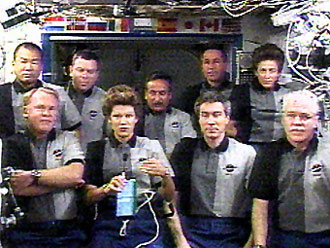Discovery Astronauts Confident in Planned Spacewalk Repair to Heat Shield

HOUSTON - TheDiscovery astronaut tapped to pluck out two strips of filler material jutting fromthe orbiter's heat shield said Tuesday that the first-time repairappears simple, but that great care must be taken to avoid damaging theshuttle.
Shuttleastronaut Stephen Robinson, a mission specialist and spacewalker for Discovery'sSTS-114 flight, said he is confident in NASA's planto send him under the orbiter Wednesday to remove two strips wedged between theheat-resistant tiles as part of third extravehicular activity (EVA) of themission. That spacewalk will begin at 3:14 a.m. EDT (0714 GMT) on Aug. 3.
"Like mostrepairs, its conceptually simple but it has to be done very, very carefully,"said Robinson, speaking via video downlink from the International Space Station(ISS) where he and other Discovery and ISS astronauts spoke to reporters. "Thetiles, as we know, are fragile and an EVA crewmember has a lot of mass, so we'llhave to be very careful."
Robinsonwill be the first astronaut to be sent beneath a NASA space shuttle, let aloneto repair its ceramic tile heat shield in orbit, when he rides the ISS roboticarm under the forward section of Discovery Wednesday. Taking care not to bumphis helmet or any other part of his spacesuit against the fragile black tilesalong Discovery's belly, he will pluck his targets - two pieces of stiff ceramicfiber cloth used to fill excess space and prevent tiles from shaking againstone another during launch.
"The maintools I plan to use are right here," Robinson said, pinching the thumb andforefinger of his right hand together. "It'll be a gentle pull with my hand andif that doesn't work I have some forceps and will give it a stronger pull. If thatdoesn't work, I saw it off with a hacksaw."
Known toNASA as gap-fillers,the small strips have been seen jutting from between tiles on orbiters in thepast and are not caused by impact or foam debris damage, shuttle officialssaid, adding that they likely became unglued from their bases during launch.
Shuttleofficials are concerned that the two gap-fillers, which jut out 1.1 inches (2.7centimeters) and up to nine-tenths (2.3 centimeters) respectively, could cause higherthan normal heating to downstream tiles and the wing leading edges duringreentry. They decidedMonday to press ahead with the repair.
Breaking space news, the latest updates on rocket launches, skywatching events and more!
Some membersof Discovery's seven-astronaut crew were concerned about the added risk of thegap-filler repair, but conceded that the straightforwardness of the task andfrom flight controllers on the ground justified the action.
"When wefirst heard about it I think a number of us did have misgivings, we were concernedabout it," said STS-114 mission specialist Andrew Thomas, who will choreographthe spacewalk repair from inside Discovery. "However, it's a lot better for a numberof performance reasons to remove the material, and that justifies doing itsince the removal should be pretty straightforward and pretty easy."
Discovery'sSTS-114 commander, veteran astronaut Eileen Collins, said she is confident thatthe repair plan drawn up by flight controllers will be effective and safe forher crew and spacecraft.
"Thissituation, I believe, will certainly be safe for us for reentry," Collins said,adding that NASA engineers have made progress in orbiter progress and repair methods."We are able to repair small types of damage...we have come to a point where we knowwhat is safe to come home with."
Collinssaid that while the gap-filler repair is a departure from the trainingRobinson and his spacewalking partner Soichi Noguchi, of the Japanese AerospaceExploration Agency (JAXA), received before launch, can be folded in line with theastronaut's experience.
"It's importantto do the gap-filler task...I think we have the flexibility to do that," Collinssaid, adding that she and her crew have been reviewing the new EVA operationstoday. "We're starting to get comfortable with it."
- Fixing NASA: Complete Coverage of Space Shuttle Return to Flight

Tariq is the award-winning Editor-in-Chief of Space.com and joined the team in 2001. He covers human spaceflight, as well as skywatching and entertainment. He became Space.com's Editor-in-Chief in 2019. Before joining Space.com, Tariq was a staff reporter for The Los Angeles Times covering education and city beats in La Habra, Fullerton and Huntington Beach. He's a recipient of the 2022 Harry Kolcum Award for excellence in space reporting and the 2025 Space Pioneer Award from the National Space Society. He is an Eagle Scout and Space Camp alum with journalism degrees from the USC and NYU. You can find Tariq at Space.com and as the co-host to the This Week In Space podcast on the TWiT network. To see his latest project, you can follow Tariq on Twitter @tariqjmalik.
